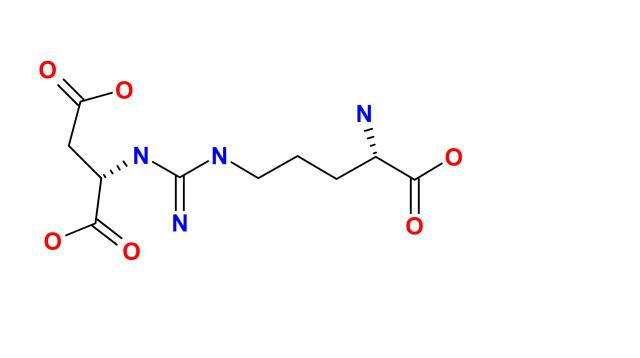Argininosuccinic aciduria
| Argininosuccinic aciduria | |
 | |
|---|---|
| argininosuccinate | |
| ICD-10 | E72.2 |
| ICD-9 | 270.6 |
| OMIM | 207900 |
Please Take Over This Page and Apply to be Editor-In-Chief for this topic: There can be one or more than one Editor-In-Chief. You may also apply to be an Associate Editor-In-Chief of one of the subtopics below. Please mail us [1] to indicate your interest in serving either as an Editor-In-Chief of the entire topic or as an Associate Editor-In-Chief for a subtopic. Please be sure to attach your CV and or biographical sketch.
Overview
Argininosuccinic aciduria is an inherited disorder that causes ammonia to accumulate in the blood. Ammonia is toxic, especially to the nervous system, and argininosuccinic aciduria usually becomes evident in the first few days of life.
An infant with argininosuccinic aciduria may seem lethargic or be unwilling to eat, have poorly-controlled breathing rate or body temperature, experience seizures or unusual body movements, or go into a coma. Complications from argininosuccinic aciduria may include developmental delay and mental retardation. Progressive liver damage, skin lesions, and brittle hair may also be seen. Immediate treatment and lifelong management (following a strict diet and using appropriate supplements) may prevent many of these complications.
Occasionally, an individual may inherit a mild form of the disorder in which ammonia accumulates in the bloodstream only during periods of illness or other stress.
Epidemiology
Argininosuccinic aciduria occurs in approximately 1 in 70,000 live births.
Genetics
Mutations in the ASL gene cause argininosuccinic aciduria. Argininosuccinic aciduria belongs to a class of genetic diseases called urea cycle disorders. The urea cycle is a sequence of reactions in the cells of the liver. It processes excess nitrogen, generated when protein is used by the body, to make a compound called urea that is excreted by the kidneys.
In argininosuccinic aciduria, the enzyme that starts a specific reaction within the urea cycle is damaged or missing. The urea cycle cannot proceed normally, and nitrogen accumulates in the bloodstream in the form of ammonia.
Ammonia is especially damaging to the nervous system, so argininosuccinic aciduria causes neurological problems as well as eventual damage to the liver.
This condition is inherited in an autosomal recessive pattern, which means two copies of the gene in each cell are altered. Most often, the parents of an individual with an autosomal recessive disorder are carriers of one copy of the altered gene but do not show signs and symptoms of the disorder.
References
- Kleijer WJ, Garritsen VH, Linnebank M, Mooyer P, Huijmans JG, Mustonen A, Simola KO, Arslan-Kirchner M, Battini R, Briones P, Cardo E, Mandel H, Tschiedel E, Wanders RJ, Koch HG (2002). "Clinical, enzymatic, and molecular genetic characterization of a biochemical variant type of argininosuccinic aciduria: prenatal and postnatal diagnosis in five unrelated families". J Inherit Metab Dis. 25 (5): 399–410. PMID 12408190
- Lee B, Goss J (2001). "Long-term correction of urea cycle disorders". J Pediatr. 138 (1 Suppl): S62–71. PMID 11148551
- Reid Sutton V, Pan Y, Davis EC, Craigen WJ (2003). "A mouse model of argininosuccinic aciduria: biochemical characterization". Mol Genet Metab. 78 (1): 11–6. PMID 12559843
- Scaglia F, Brunetti-Pierri N, Kleppe S, Marini J, Carter S, Garlick P, Jahoor F, O'Brien W, Lee B (2004). "Clinical consequences of urea cycle enzyme deficiencies and potential links to arginine and nitric oxide metabolism". J Nutr. 134 (10 Suppl): 2775S–2782S, discussion 2796S-2797S. PMID 15465784 Full text
- Stadler S, Gempel K, Bieger I, Pontz BF, Gerbitz KD, Bauer MF, Hofmann S (2001). "Detection of neonatal argininosuccinate lyase deficiency by serum tandem mass spectrometry". J Inherit Metab Dis. 24 (3): 370–8. PMID 11486903
- Wilcken B, Smith A, Brown DA (1980). "Urine screening for aminoacidopathies: is it beneficial? Results of a long-term follow-up of cases detected bny screening one million babies". J Pediatr. 97 (3): 492–7. PMID 7411317
External links
- ucd-overview at NIH/UW GeneTests